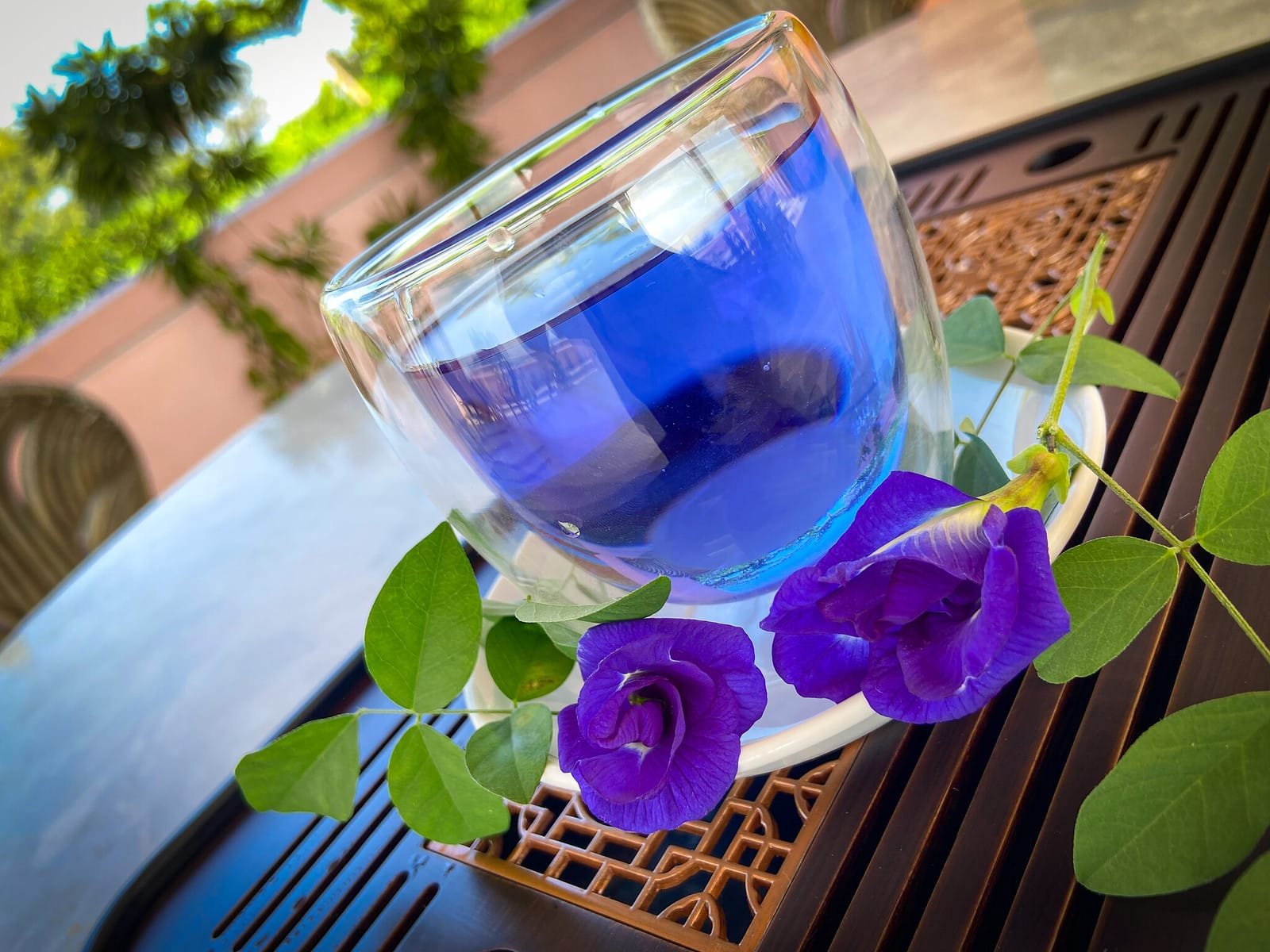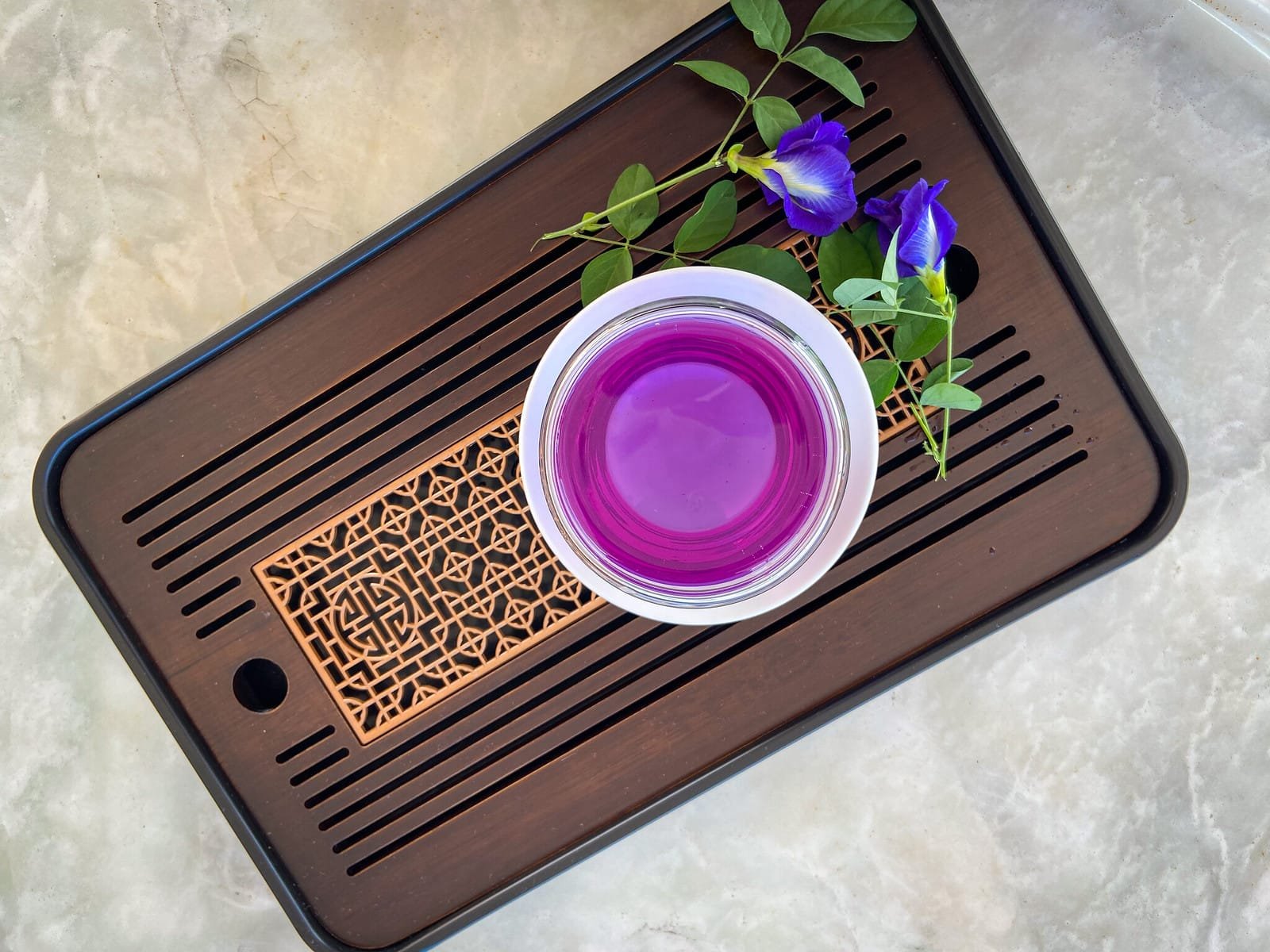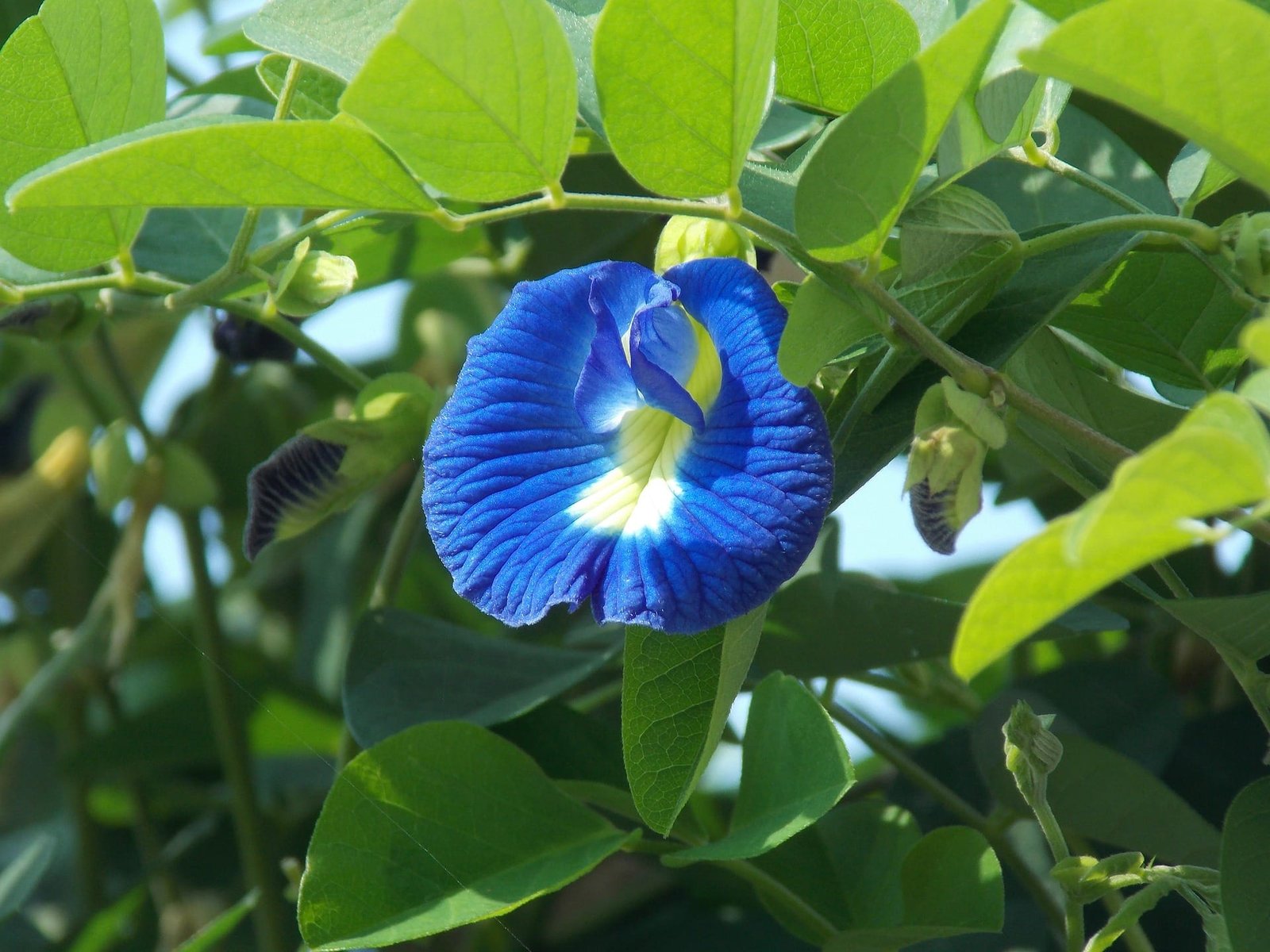Blue tea, made from the Butterfly Pea flower, has become a popular trend drink on social media. No wonder, because its bright blue color makes it a real eye-catcher. If you add a few dashes of lemon juice or hibiscus flowers, the blue tea even turns a gorgeous purple, pink or red. You can find out more color combinations, as well as everything you need to know about the preparation and health effects of the blue Butterfly Pea tea in this article.

Inhalt
ToggleWhat is Butterfly Pea Tea?
In contrast to green, yellow, white or black tea, blue tea is not made from the Camellia Sinensis tea plant and has no caffeine. Blue tea has many other names: Butterfly Pea Tea, Asian Pigeonwings, Bluebellvine, Blue Clitoria and the scientific name Clitoria Ternatea. The plant originally comes from northern Thailand, where it is called Anchan.
The Butterfly Pea plant is the source of these vibrant blue flowers, which are used in traditional medicine and as a natural colorant in food and beverages. Growing this plant is relatively straightforward as it grows well in tropical climates and provides abundant petals for the preparation of Butterfly Pea Tea. The flower not only provides visual and flavor qualities to the tea, but is also valued for its health benefits.
- Guaranteed Quality and Freshness
- Secure Payment
- Fast Shipping
Tobias
How to prepare Blue Tea
The preparation of Butterfly Pea Tea is simple but spectacular. All you need are dried Butterfly Pea flowers and hot water. Pour boiling water over 2 teaspoons (4-8 flowers) of Butterfly Pea flowers and leave the tea to infuse for between 5 and 10 minutes, depending on the desired intensity. The result is an intense blue color tea. For special effects, you can now add other ingredients…
The Fascinating Color Change of Butterfly Pea Tea
The fascinating play of colors begins with the tea’s vibrant blue color, which changes when you alter the pH value. The water-soluble color pigments react to this. If you add lemon or lime, you can watch the color change from blue to purple. If you brew the Butterfly Pea flowers together with Hibiscus flowers the natural acidity of the hibiscus produces a magnificent red or pink color.
You can achieve the opposite by increasing the pH value. For example, if you add a little baking soda to the cup, the blue suddenly turns green. However, be careful not to use too much baking soda to avoid affecting the taste.
This natural phenomenon makes tea an ideal candidate for experimental cocktails, iced teas and even desserts. Here you can find a Recipe for butterfly pea latte.

What does Butterfly Pea Tea taste like?
The taste of Butterfly Pea flower tea is very mild and rather unspectacular. You could compare the flavors to a light green tea, with a slightly earthy and sweet note. The addition of lemon and honey not only creates a beautiful visual effect, but also refines the taste. The inconspicuous taste of Blue tea makes it ideal for coloring other drinks and foods.
Butterfly Pea Flower Health Benefits
In addition to its stunning appearance, blue tea also offers a wealth of health benefits. The traditional Asian medicinals have used the plant for centuries to treat various ailments, and now modern science is beginning to confirm this ancient wisdom. There are several studies that suggest Butterfly Pea may offer multiple health benefits, including anti-inflammatory, pain-relieving, memory-enhancing, antioxidant and hepatoprotective effects. These research results underline the therapeutic potential of the plant and support its traditional use in various cultures.
1. Strong Effect of Blue Tea Against Inflammation
Studies with root extracts of Butterfly Pea have been shown to be effective in reducing inflammation and pain. The flowers may have similar properties to the root extracts. In a study on animals, the plant was used to inhibit the growth of edema and reduce fever (Parimala Devi, Boominathan Mandal, 2003).
2. Memory-Enhancing Effect
The blue Butterfly Pea flowers have traditionally been used to improve mental performance and memory. Studies have shown that alcoholic extracts of the plant produced significant memory retention in rats. The extracts increased acetylcholine levels in the rats’ brains, suggesting a possible explanation for the anti-amnesic effects (Taranalli Cheeramkuzhy, 2000), (Damodaran et al., 2018).
3. Antioxidant Properties
It is believed, that the Butterfly Pea Flower has a protective effect against oxidative stress on skin cells. This could be due to its antioxidant properties. It could thus provide protection against UV-induced mtDNA damage (Zakaria et al., 2018).
4. Improvement of Blood Circulation and Relaxation of the Scalp
The application of Butterfly Pea Flower extract or oil on the scalp, may contribute to improved blood circulation. Although specific studies on the effect on scalp circulation are limited, it is known that plants with antioxidant properties, such as Butterfly Pea, can potentially reduce inflammation and promote blood circulation. Improved blood circulation supports the supply of nutrients to the hair follicles, which can lead to healthier hair growth and at the same time have a relaxing effect on the scalp. This relaxing effect may also be due to the presence of flavonoids and other calming compounds in the petals (Choochuen Jimtaisong, 2022).
5. Positive Effect on Stress and Depression
Butterfly Pea Tea also shows promising results in the treatment of stress and depression. Various studies have investigated the anxiolytic and antidepressant properties of the plant, which can be attributed in part to its ability to modulate central neurotransmitter activity. For example, the use of Butterfly Pea extracts in experimental models has shown a reduction in stress symptoms and an improvement in mood. (Parvathi Ravishankar, 2013)
6. Butterfly Pea Flower could Protect the Liver
The leaves of the plant could potentially help to protect the liver. This is particularly useful if the liver has been damaged by drugs such as paracetamol. The protective function of the leaves comes from the powerful antioxidants they contain, such as phenols and flavonoids. These substances may help to strengthen the liver and reduce damage. In studies with mice, it was seen that mice that were given an extract of the leaves had lower levels of certain liver enzymes. This means that their livers were healthier compared to mice that were not given this extract (Nithianantham et al., 2011).
The leaves of the plant could potentially help to protect the liver. This is particularly useful if the liver has been damaged by drugs such as paracetamol. The protective function of the leaves comes from the powerful antioxidants they contain, such as phenols and flavonoids. These substances may help to strengthen the liver and reduce damage. In studies with mice, it was seen that mice that were given an extract of the leaves had lower levels of certain liver enzymes. This means that their livers were healthier compared to mice that were not given this extract

Is Butterfly Pea (Clitoria Ternatea) illegal in the EU?
The question of whether butterfly pea tea is banned sometimes causes confusion. The short answer: blue tea is not banned! However, the Clitoria Ternatea plant is not permitted as a foodstuff in the EU. This is due to the Novel Food Regulation. According to this regulation, all plants that were not consumed to any significant extent in the EU before 1997 must be explicitly applied for and approved as foodstuffs. This is a complex and expensive process that is generally not worthwhile for a natural product.
The fact that blue butterfly flower tea is not approved as a beverage does not, of course, mean that it is forbidden to buy or prepare it. You can enjoy your blue tea without any worries. There are no known side effects. However, as with all herbal teas, interactions with medication can potentially occur. Talk to your doctor before drinking butterfly pea tea if you are taking medication.
Conclusion
As you’ve seen, blue tea is much more than just a visually stunning eye-catcher in cocktails and desserts. The fascinating transformation of the color is a beautiful party trick. Butterfly Pea Tea also has a number of health benefits. You can get high-quality organic Butterfly Pea Flower Tea
Frequently Asked Questions (FAQs)
Yes, Butterfly Pea tea is known for its health benefits, including antioxidant properties that can help improve brain performance and heart health.
For an optimal taste experience, Butterfly Pea tea should steep for about 5 to 10 minutes. The infusion time can be adjusted according to personal preference for the intensity of the flavor.
Yes, butterfly flowers are edible and are often used in salads, as a garnish for dishes or to add color to desserts.
Butterfly flowers have a bright blue color with a slight funnel shape. They are known for their eye-catching appearance, which makes them an eye-catcher in any garden or dish.
Blue tea is made from the Clitoria Ternatea plant, also known as butterfly flower or butterfly pea.
Butterfly Pea Tea has a mild, earthy taste with a slight sweetness. The taste can be refined with additives such as honey, lemon or mint, depending on your preference.
Blue tea can be enjoyed both hot and as a refreshing iced tea. It can be drunk pure or enhanced with lemon juice and honey for added flavor and an impressive color change.
Pour hot water over a handful of butterfly flowers and leave the tea to infuse for around 5 to 10 minutes. For a more intense color and taste, you can increase the amount of flowers or the infusion time.
No, blue tea naturally contains no caffeine, making it an ideal choice for people who prefer caffeine-free drinks.



